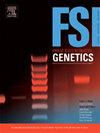COMBO: An AmpliSeq-based trilogy for autosomal and uniparental (Y & mito) biogeographical ancestry and appearance testing
IF 3.1
2区 医学
Q2 GENETICS & HEREDITY
引用次数: 0
Abstract
Forensic DNA phenotyping has become an increasingly important technology for narrowing down potential stain donors in forensic investigations. Over the past decade, the number of genetic markers required for reliable predictions has steadily increased, posing significant challenges for molecular genetic assay designs. These parallel designs often consume valuable DNA extracted from forensically relevant materials. To minimize DNA wastage, it is crucial to integrate as many markers as possible into a single analytical approach. Massively Parallel Sequencing (MPS)-based technologies have enabled the simultaneous analysis of up to several hundred genetic markers in one reaction. However, to date, marker panels from nuclear and mitochondrial DNA have not been integrated. This limitation has led to increased consumption of evidentiary DNA, as parallel analytical schemes are required to analyze both types of markers. This study presents the development, optimization and validation of the COMBO Panel, which combines autosomal and uniparental (Y-chromosomal and mitochondrial DNA) markers for ancestry and appearance testing. The COMBO panel contains 524 (VISAGE Enhanced Tool, ET) or 153 (VISAGE Basic Tool, BT) markers for the prediction of appearance and ancestry with 781 Y-chromosomal SNPs and 162 mtDNA amplicons covering the entire mitogenome. Library generation is based on AmpliSeq technology, which allows simultaneous analysis of all markers in a single sequencing run. The VISAGE ET panel was used in the optimization phase as well as in the initial trials of the COMBO assay and was later replaced with the VISAGE BT panel to streamline the test and adjust the primer concentrations accordingly. The COMBO panel was analyzed using Ion GeneStudio S5 systems for testing sensitivity and reproducibility, sex and species specificity, mock and real casework, degraded DNA and historical samples.
COMBO:基于ampliseq的常染色体和单系(Y & mito)生物地理血统和外观检测三部曲
法医DNA表型分析已成为法医调查中缩小潜在染色供体的越来越重要的技术。在过去的十年中,可靠预测所需的遗传标记数量稳步增加,对分子遗传分析设计提出了重大挑战。这些平行设计经常消耗从法医相关材料中提取的有价值的DNA。为了最大限度地减少DNA浪费,将尽可能多的标记整合到单一分析方法中至关重要。基于大规模并行测序(MPS)的技术已经能够在一个反应中同时分析多达数百个遗传标记。然而,迄今为止,来自细胞核和线粒体DNA的标记面板尚未整合。这一限制导致证据DNA的消耗增加,因为需要平行分析方案来分析两种类型的标记。本研究介绍了COMBO面板的开发、优化和验证,该面板结合了常染色体和单亲本(y染色体和线粒体DNA)标记,用于血统和外观测试。COMBO面板包含524个(VISAGE Enhanced Tool, ET)或153个(VISAGE Basic Tool, BT)标记,用于预测外观和祖先,具有覆盖整个有丝分裂基因组的781个y染色体snp和162个mtDNA扩增子。文库生成基于AmpliSeq技术,该技术允许在单次测序运行中同时分析所有标记。VISAGE ET面板用于优化阶段以及COMBO试验的初始试验,随后被VISAGE BT面板所取代,以简化测试并相应地调整引物浓度。使用Ion GeneStudio S5系统分析COMBO面板,测试灵敏度和可重复性、性别和物种特异性、模拟和真实案例、降解DNA和历史样本。
本文章由计算机程序翻译,如有差异,请以英文原文为准。
求助全文
约1分钟内获得全文
求助全文
来源期刊
CiteScore
7.50
自引率
32.30%
发文量
132
审稿时长
11.3 weeks
期刊介绍:
Forensic Science International: Genetics is the premier journal in the field of Forensic Genetics. This branch of Forensic Science can be defined as the application of genetics to human and non-human material (in the sense of a science with the purpose of studying inherited characteristics for the analysis of inter- and intra-specific variations in populations) for the resolution of legal conflicts.
The scope of the journal includes:
Forensic applications of human polymorphism.
Testing of paternity and other family relationships, immigration cases, typing of biological stains and tissues from criminal casework, identification of human remains by DNA testing methodologies.
Description of human polymorphisms of forensic interest, with special interest in DNA polymorphisms.
Autosomal DNA polymorphisms, mini- and microsatellites (or short tandem repeats, STRs), single nucleotide polymorphisms (SNPs), X and Y chromosome polymorphisms, mtDNA polymorphisms, and any other type of DNA variation with potential forensic applications.
Non-human DNA polymorphisms for crime scene investigation.
Population genetics of human polymorphisms of forensic interest.
Population data, especially from DNA polymorphisms of interest for the solution of forensic problems.
DNA typing methodologies and strategies.
Biostatistical methods in forensic genetics.
Evaluation of DNA evidence in forensic problems (such as paternity or immigration cases, criminal casework, identification), classical and new statistical approaches.
Standards in forensic genetics.
Recommendations of regulatory bodies concerning methods, markers, interpretation or strategies or proposals for procedural or technical standards.
Quality control.
Quality control and quality assurance strategies, proficiency testing for DNA typing methodologies.
Criminal DNA databases.
Technical, legal and statistical issues.
General ethical and legal issues related to forensic genetics.

 求助内容:
求助内容: 应助结果提醒方式:
应助结果提醒方式:


